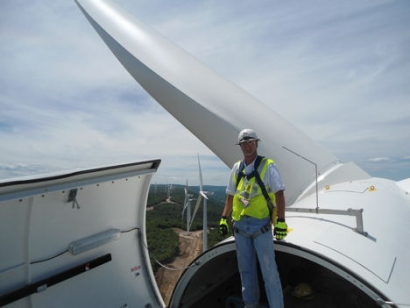
The U.S. is currently the second-largest wind power market globally – supplying 7.3% of the nation’s electricity generation in 2019 – yet this is the first research effort to evaluate the impact of plant age on the performance of the U.S. wind fleet.
In order to model the projected growth of wind power and determine the financial viability of wind plants, researchers and investors need to take into account wind plant degradation over time. Studies in Germany, Sweden and the United Kingdom have shown that differences in each region’s weather, geography and policies, as well as differences in technology can impact wind fleet performance over time.
A team of researchers in the Energy Analysis & Environmental Impacts Division at Berkeley Lab analyzed the performance of 917 onshore wind projects in the United States. Their findings were published recently in the journal Joule.
The team found relatively little performance decline in US wind plants: they maintain 87% of peak performance after 17 years, and newer plants show almost no decline over the first 10 years. The findings show that the U.S. wind fleet performance decline per year is on the low end of the range found in Europe. The studies conducted in Europe, however, found that
performance declined linearly over time, whereas in the U.S., the degradation does not happen smoothly over time. Instead, Berkeley Lab found a more abrupt change in performance of U.S. wind plants after 10 years of operation, which also coincides with when U.S. wind plants lose eligibility for the production tax credit (PTC).
In the US, the PTC was implemented as part of the Energy Policy Act of 1992 to incentivize wind power development and installation. The PTC provides wind plants with a production-based tax credit for their first ten years of operation, and the authors suggest that the ten-year duration of the PTC impacts the performance degradation rate of U.S. wind plants.
“We hypothesize that after wind plants lose eligibility for the PTC, they may choose to spend less on maintenance overall and their performance may therefore drop,” said Research Scientist Dev Millstein, an author on the paper. “So, a sort of ‘bonus’ effect of the production tax credit policy is that operators may be keeping their plants running at peak performance
while the policy is active.”
Understanding that performance decline is influenced by both physical degradation and maintenance cost-benefit trade-offs, which can be driven by policies, is important for modeling wind power costs and energy generation.
The research team hopes this study will lead to further analysis and more large-scale data sharing from wind project operators in order to improve knowledge of U.S. wind plant performance, and guide more effective decision-making by industry, academia and policy makers.

